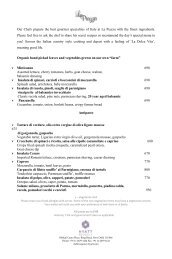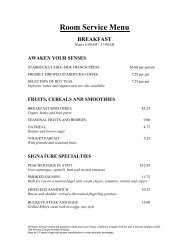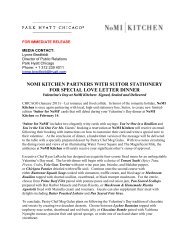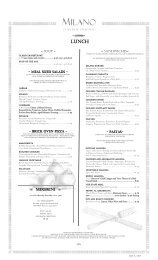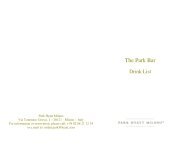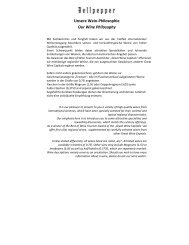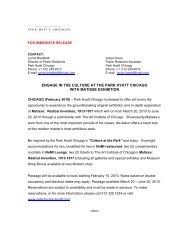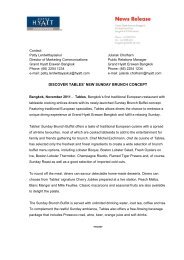KUNST IM GRAND HYATT BERLIN - Hyatt Hotels and Resorts
KUNST IM GRAND HYATT BERLIN - Hyatt Hotels and Resorts
KUNST IM GRAND HYATT BERLIN - Hyatt Hotels and Resorts
Erfolgreiche ePaper selbst erstellen
Machen Sie aus Ihren PDF Publikationen ein blätterbares Flipbook mit unserer einzigartigen Google optimierten e-Paper Software.
Peter Zimmermann *1956 in Freiburg; lebt und arbeitet in Köln<br />
Am Anfang ist meist das Epoxidharz, in dem Farbpigmente<br />
gelöst sind. „Ab einem bestimmten Zeitpunkt malt sich das<br />
Bild selbst. Du hast es dann nicht mehr in der H<strong>and</strong>. Du<br />
kannst es auch nicht mehr stoppen oder zurücknehmen.<br />
Das Epoxidharz hat eine so lange Fließzeit, bevor es abbindet,<br />
dass die Bilder häufig am <strong>and</strong>eren Morgen ganz <strong>and</strong>ers<br />
aussehen, als ich sie am Abend verlassen habe“, erklärte<br />
Peter Zimmermann seine Materialwahl. Kein schlechtes Mittel,<br />
um sich mit Bildpotenzial, letztlich mit Kunst und Technik<br />
ausein<strong>and</strong>erzusetzen. Dieser Mann ist ein Aufklärer, ein Formenhinterfrager.<br />
In der Executive Suite geht es um eine Annäherung<br />
an den abstrakten Expressionismus eines Jackson<br />
Pollock. Was aussieht wie ein nachgelassenes Plakat, das<br />
für eine abgespielte Ausstellung Pollocks wirbt, entpuppt<br />
sich als tiefschürfendes Nachdenken über Singularität und<br />
Reproduktion. Zimmermann geht es um die Malerei und die<br />
Frage, in welcher Weise die Medien des Vorgefundenen, also<br />
Computer, Internet oder Filme, die Intuition beherrschen.<br />
Zimmermanns Bilder sind meist Ausein<strong>and</strong>ersetzungen mit<br />
dem, was die universelle Maschine hergibt – wo hört Kunst<br />
auf, wo fängt Digitalisierung an, wie verschieben sich die Bilder?<br />
Man könnte das alles auch Medienkunst nennen, auf<br />
jeden Fall aber einen Versuch, dem Effekt auf die Schliche<br />
zu kommen.<br />
28<br />
In the beginning, there is only the polyepoxide in which the<br />
colour pigments are mixed. “At a certain point, the picture<br />
will paint itself <strong>and</strong> you will no longer have any control over<br />
the outcome. It is no longer possible to stop it or take it back.<br />
The polyepoxide takes so long to settle that the pictures often<br />
look completely different in the morning compared to<br />
how I left them the evening before”, says Peter Zimmermann<br />
about his choice of material. A suitable choice, it seems, if<br />
you want to explore the potential of an image <strong>and</strong> explore<br />
the combination of art <strong>and</strong> technique. Zimmermann explores<br />
<strong>and</strong> questions art in his piece in the Executive Suite as he<br />
attempts to grasp the abstract expressionism of a Jackson<br />
Pollock. What looks like a discarded poster for an outdated<br />
Pollock exhibition develops somehow into a contemplative<br />
piece about uniqueness <strong>and</strong> reproduction. Painting is everything<br />
to Zimmermann, <strong>and</strong> he wants to explore how computers,<br />
the Internet <strong>and</strong> movies that we encounter every day<br />
control our intuition. Where does art cease to be <strong>and</strong> where<br />
does digitalisation start? You could call it media art or, in any<br />
case, an attempt to grasp its effect.<br />
Jackson Pollock rot/Jackson Pollock Red, 1998




